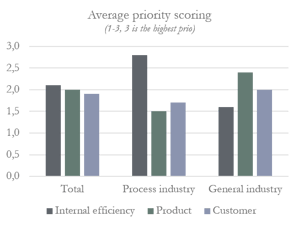How do you effectively manage investments in digitalization these days? Many topics need to be covered for being able to answer this question. We have now tried! Through contacting some of the largest Swedish manufacturing industry companies we digged deeper and discussed how they approach and carry out their digitalization strategy. Sixteen companies in total took part in our study, of which ten are large cap. We explored how they set direction for their digitalization work, status of their digital maturity, what opportunities they see in future technology and what type of leadership they believe will be required. The results from our interviews show there is still extensive untapped potential in the ongoing digital transformations.
Setting direction for the digitalization work is critical – but not all agree
Is it important to set a target state for your digitalization work? When posing this question to the leaders in our study, there is a divide in beliefs and approaches. Half the group strongly believes in setting a target state, even if they may explain different ways of doing it. The other half of the group believes that you cannot really define a target state for digitalization today. They claim you can shape some sort of vision, but with things moving so fast these days there are too many unknowns, so a more specific target state cannot be set nor be helpful.
We believe setting a target state for the digitalization work is critical, at least on high-level as a guiding lighthouse that can be communicated to the organization. From previous experience we have seen that a target state can be expressed in different forms. It can be a set of guiding principles or preferably also a visualization of key digitalization elements to target when going through the transformation. The detailed path might be revised along the way, but the agreed direction is still there as an important guidance.
Customer centric and Product oriented digitalization investments are increasing, but Internal efficiency is still the highest priority
When respondents are forced to rank the priority of digitalization investments, Internal efficiency is in general ranked the highest. However, Customer and Product have gained focus and priority, scoring close to the same level.

There is a natural divide in prioritization when comparing process manufacturing industry to general more discrete manufacturing industry.
Process manufacturing industry prioritizes Internal efficiency much higher than Customer and Product. This is of course a natural consequence of producing a commodity type of product, with efficiency and low cost as a focus. On the other hand, we see that priority of investments in Customer and Product is increasing in comparison, which most likely is a trend that will continue.
General manufacturing industry, including discrete and consumer goods manufacturing, prioritizes Customer the highest on average and Product comes second. If we would have conducted this study a few years ago, Internal efficiency would probably have been prioritized higher, but it seems that many have started progressing away from that focus.
Data is critical when facing today’s drivers for digitalization
There are many drivers behind digitalization today, that business leaders need to take into consideration. The sixteen respondents in our study raised and reflected around an extensive set of drivers they see are important. We have concluded five drivers that has been valued higher than others among the respondents.

- Digital automation is a driver for digitalization which has been important for many years already. However, there are more and more tools and technologies becoming available today, that can help enable the automation. Some digitalization investments go to automation of administrative work, through for example RPA. More extensive investments are spent on making operations smarter, through for example machine learning and AI enabled video analysis capturing quality deficiencies in production.
- Sustainability is continuously gaining more and more attention. To be able to report level of sustainability accurately, access to data is critical. Historically the sustainability reporting has been dependent on manual and time-consuming number crunching in excel sheets. Now the reporting is enabled by data and automated, and the strive for continuously becoming more sustainable is enabled by digitalization.
- Data intelligence is one of many names for a large and complex area, that needs to be carefully managed from multiple angles. The objective is to get new value from data, which could be denoted as intelligence. It could be intelligence about the customers’ products so that value-added services can be sold as a result of the data. Customers can also ‘pay per use’ and buy ‘as a service’ thanks to data. But enabling the intelligence and reaping new values is complex and cumbersome. Data needs to be of good quality, always. Data needs to be collected, analyzed, and applied in real-time. Then visualized for fact-based and efficient decision making. In the long run the data also needs to be structured and 100 % trusted so that it can fuel machine learning and AI enabled automation without disruptions.
- Cyber security as a driver is a natural consequence of the increasing amount of data and the transformation towards cloud. Cyber security is not necessarily a driver for digitalization as such, but with more severe ransom cases and production facilities being locked in a stand-still, this is very high up on the agenda. Some CIOs have started reporting cyber security status to the actual board of their company. Digitalizing in a secure manner and having full awareness about threat levels is key to the success of a CIO today.
- Demography and competence shift is a consequence of digitalization, but also an area where digitalization can help companies prepare for the future. Today a lot of knowledge is kept with key individuals across the organization. When they retire the knowledge is lost. However, digitizing and digitalizing around their knowledge can help avoid that loss. Additionally, digitalization puts pressure on securing future needs of competence. If you have not yet hired a data scientist, as an example, it is time to act. However, you will also need to have a strong digitalization agenda for attracting people with these deep and highly demanded skills.
The manufacturing industry needs to work on the digital maturity
The respondents were asked to give their company an indicative digital maturity score from 1-10, comparing their company to competitors and others in their industry. The average digital maturity score they gave was around six (6). We consider this as quite low. You would think that scoring lower than five should imply that you will not cope for very long in today’s fierce competition. On the other hand, the average digital maturity score of six signals an ambition and a strive for continuously improving towards new goals in the digital transformation.

There are a couple of interesting conclusions when looking more closely into the digital maturity data:
- Those ranking Customer as the highest priority for digitalization investments have an average digital maturity score of eight (8).
- On the other hand, those ranking Internal efficiency as the highest priority have an average digital maturity score almost as low as five (5).
- Hence, those prioritizing Customer the highest have ~50 % higher maturity compared to those prioritizing Internal efficiency as the highest.
Our study has also concluded findings and insights across a set of more qualitative topics:
- Innovation
- Governance
- Collaboration
- Decision making
- Execution
These five topics will be described with some more study conclusions in our next second blog article covering our digitalization study. Keep an eye open!
About Centigo
Centigo is a management consulting company with many years of experience in cross-functional business development and digitalization. Within the manufacturing industry we help companies with, among other things, strategy formulation, process development, evaluation and introduction of digital tools and solutions as well as change management.

Jonas Ekman
Advisor and project manager in digitalization for the manufacturing industry

Johan Andersson
Client director and advisor in strategy execution and organisational agility


